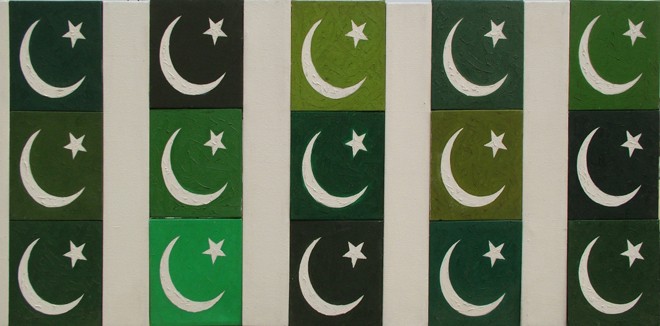
Artists have designed flags and used them in their art works too. Come August the popular aesthetics are experimenting with the standard visual of green and white

On Monday mornings it is difficult to walk in a public park; the residue of well-spent Sunday picnics is seen all across the parks. Last week, along with the usual soft drink bottles, empty wrappers of crisps and polythene bags, there was something different -- small papers printed with national flag scattered on the ground.
That the national flag was tossed on the ground was not as shocking as the fact that a different colour was printed in place of usual green. One is not sure whether these flags, printed as buntings, were the product of some adventurous businessmen who wanted to add something new into the normal order or were the result of a printing error. But their presence raised a basic issue: the rationale behind the design and colour scheme of our national flag or for that matter flags of other nations too.
It would be relevant to invoke the history of flags to see how emblems of different tribes, territories and societies of ancient times turned into a standardised rectangle (in most cases) flags for present day nation-states.
Flags are not limited to countries only. Provinces, cities, government organisations official departments and private bodies (like army, police, railway, universities, clubs) have their separate flags seen during public functions or sports competitions. The most visible are the flags of political parties displayed during election campaigns.
Individuals who design and decide on the colour and pattern of these flags can have varied aesthetic tastes. These sacrosanct and revered entities are actually ‘made’ by a mortal but one tends to forget this elementary detail in one’s national fervour. Thus any disagreement with the design or composition of a flag is usually considered disrespectful.
One can’t imagine someone would have the courage to question the artistic merit of green and white flag. No one in his right mind would examine the formal aspects of joining two colours as different as green and white to create a national visual or suggest an artistic improvement in our national flag. Anything like this is likely to be perceived as extremely rude, and almost sacrilegious. The flag is considered the most important and potent symbol of national identity which can not be amended like other signs of federation such as the Constitution or currency.
In a way, flag and national anthem too are viewed like the borders of a country, and a shift in any of these is not accepted. There is some connection too because the flag of United Kingdom may change if Scotland decides to have its independent rule in September this year, and there have been suggestions to remove the word ‘Sindh’ from the Indian national anthem.
But borders alternate and so do flags. Yet in a majority of countries it is unimaginable and unacceptable to change the national flag, even if it is not too pleasant design-wise.
Several artists have used the national flags in their art works. The most illustrious example is of Jasper Johns who made paintings (such as Three Flags, 1958) based upon the US flag. American art critic Leo Steinberg in his book Other Criteria discusses these flags not as representing national emblems but the artist’s desire to choose a flat visual to reinforce the two-dimensionality of painting. Italian artist Alighiero e Boetti also employed the images of world flags in his work (Mappa, 1971-89); likewise the Iranian-born Sara Rahbar is creating images of American flag in her mixed-media installations.
The most challenging work related to the idea of national flags was made by Japanese artist Yukinori Yanagi shown at the Venice Biennale in1993. Yanagi arranged coloured sands, reproducing flags of different countries, in various plastic rectangle boxes, all connected through tiny transparent plastic tunnels, and added ants in the installations. With every passing day these creatures shifted sand from one box to other, so by the end of the Biennale all national flags became singular in colour and identical in imagery.
Mahbub Shah and Zahid Hussain also appropriated the elements of flag to denote the situation of Pakistani society. In Shah’s Sabz Parcham, (2001) small frames of national flag (part of one painting) are daubed in green colour of all shades, tones and intensity, while white is the same in each frame. This is a comment on the practice of selling Pakistani flags in all shades and also indicates the irony of Muslims being one majority in Pakistan yet the colour that represents them is varied, whereas minorities belong to different religions but their colour is uniformly white.
Along with these examples of artists using national flag for their creative plans, the popular aesthetics is also experimenting with the standard visual of green and white, and the crescent and star. In the month of August, different flags are up for sale on roadside stalls. Here one comes across all sorts of variations on the national flag, including crescent and star transformed into text about freedom day. Or slogans such as ‘Happy National Day’, or ‘Celebration of Freedom Festival’ (in Urdu) added into the green part. Or picture of the father of nation printed on the white section. Perhaps the most interesting design is that of Mickey Mouse included on the white area of national flag (a folk interpretation of idea of nationality in the age of marketing and globalisation), and is certainly done to attract kids.
For the adults, a minor change -- reducing the white section on the flag -- would do. This is just a suggestion because, with the passage of time and our treatment of minorities, many of them are either dead or have migrated abroad.